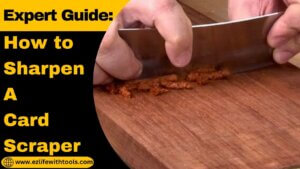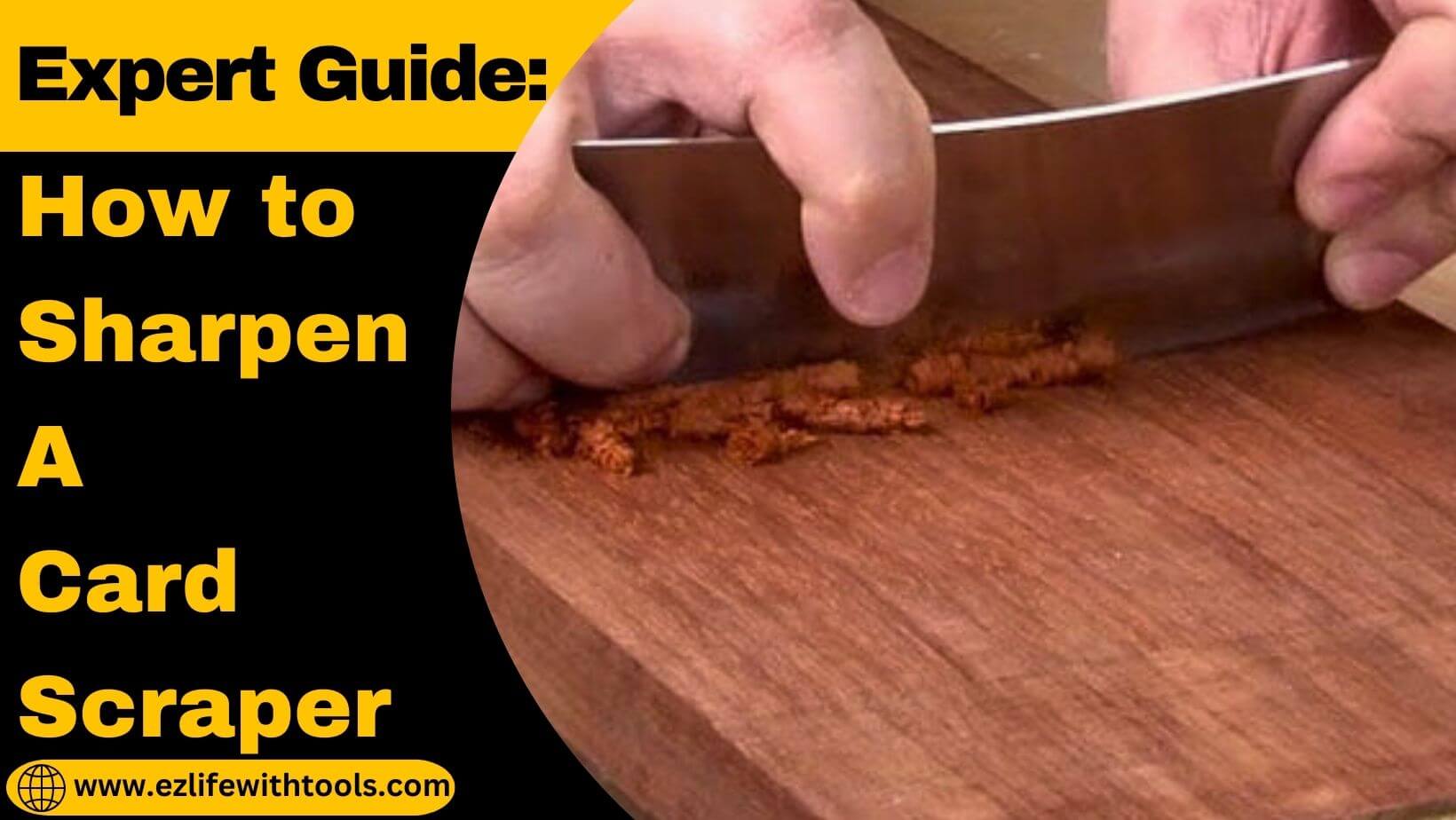How to Sharpen a Card Scraper Step-by-Step: Expert Guide
Crafting precise and flawless woodwork often depends on the mastery of tools, and one such paramount tool

for woodworkers is the card scraper.
A card scraper, despite its seemingly straightforward appearance, demands finesse and skill to unleash its full potential.
Sharpening this unassuming yet powerful instrument is an art form in itself, crucial for achieving unparalleled smoothness and finesse in woodworking projects.
If you want to learn that how to sharpen a card scraper with all strategies.
In this comprehensive guide, we will explain the complications of sharpening a card scraper, the step-by-step process, techniques, and expert tips required to transform this tool into a refined implement capable of producing flawless finishes.
What is a Card Scraper?
A card scraper is a hand tool made of a thin, flat, and flexible metal blade. It looks like a simple flat metal plate, but it is sharpened to remove fine shavings of wood from a workpiece’s surface. It delicately shears wood fibers, resulting in a pristine finish.
Types of Card Scrapers
Card scrapers come in various shapes, sizes and thicknesses. All are designed to meet some specific needs. Understanding the different types of available card scrapers is necessary because you can choose the most suitable tools for your project according to your needs.
Basically, there are two types.
- Rectangular Card Scraper
- Curved Card Scraper
1- Rectangular Card Scrapers
These are the most common types of card scrapers. They have a flat, straight-edged profile crafted from high-quality flexible steel.
Due to its flexibility, you will be able to shape the various surfaces of wood.
They come in different thicknesses, which helps to adjust the tool according to the specific requirements of the project.
Additionally, rectangular scrapers are relatively easy to sharpen and maintain.
2- Curved card scraper
A curved card scraper, also known as a gooseneck scraper. It has multiple curves in it. These multiple curves allow artisans to shape irregular and concave surfaces like chair legs, table edges, and complex mouldings.
Rectangular scrapers can’t address these surfaces wisely. Access concave or irregularly shaped surfaces that may be difficult to address with a straight-edged scraper.
The curvature of these scrapers enables woodworkers to navigate complex shapes and create smooth finishes on curved surfaces without causing unintended marks or scratches.
Understanding the Science Behind Card Scraper Sharpening
Card scrapers are simple yet effective woodworking tools made of hardened steel. They work by using a small, thin piece of metal that, when properly sharpened, acts like a small hand plane.
Sharpening a card scraper revolves around manipulating and refining the small pit (or hook) along the edge of the tool, which is critical to its cutting action.
I have described its typical anatomy to understand its function, which will help you sharp the card scraper.
- Metal construction: Usually made of high-quality steel, card scrapers have a hardness level that allows them to be sharpened to a fine edge, allowing for fine wood removal.
- Edge Shaping: The cutting edge of a card scraper should be square and well-defined to work effectively. It is very important to ensure that the edges are kept free of nicks or irregularities to achieve a consistent scraping action.
- Card Scraper Functionality: The process of sharpening a card scraper involves making and maintaining a small, curved burr along the edge. This molasses is what interacts with the surface of the wood, cutting the thin shavings to create a smooth finish. How this pulp is obtained and manipulated determines the performance and effectiveness of the card scraper.
- Importance of Sharpening: A properly sharpened card scraper is a game changer in woodworking. It allows fine shavings to be removed, eliminating the need for sanding in many cases. The ability to finely adjust the angle and sharpness of the burr gives woodworkers control over the cutting process, making it a versatile and accurate tool in their arsenal.
Tools Required for Sharpening a Card Scraper
Sharpening a card scraper requires a few essential tools. Because accuracy and efficiency during the process depend on these tools, these tools help to shape and refine the scraper edge to achieve the desired cutting performance.
Here is a list of essential tools:
- Card Scraper: It is a simple, thin, flat and flexible plate of rectangular metal, which helps to create a fine and smooth finishing surface of wood.
- Mill File: A mill file is a cutting tool used in metalworking and woodworking, having a flat cross-section with parallel rows of teeth for precisely shaping, smoothing, or sharpening the surfaces.
- File Jointer: A piece of metal or wood to hold the mill file securely at 90 degrees. You can use it to sharpen the card scraper edge without damaging your hands.
- Burnisher: It is an essential tool to create a burr on the card scraper and then turn it into a hook. It consists of a hard steel rod.
- Honing Stone: It is an abrasive tool which is used to sharpen and refine the edges of cutting tools, blades and card scrapers. It is also known by the name of whetstone.
- Workbench or safe work surface: A stable work surface is vital for consistency and safety during the sharpening process. Clamp the card scraper securely to prevent movement while working on it.
- Honing Fluid (Optional): Some woodworkers prefer to use a lubricant or honing fluid when sharpening to facilitate smooth movement and to prevent the scraper edge from overheating.
How to Sharpen a Card Scraper Step-by-Step
Sharpening a card scraper involves a series of complex steps that refine the edge and create a burr, which is essential for its cutting process. This process demands attention to detail and precision to achieve maximum results.
Here is a detailed breakdown of the involved steps:
1st Step- Test the Card Scraper Status:
First of all, Check the card scraper on a scrap piece of wood. Is it working or not?
If it shaves wood properly, then you can use it. But if you find that it is dull and not working properly, then move forward to the next step of sharpening.
2nd Step- Connecting the Edges:
- In the second step, you will remove the old burr on the card scraper because it is no longer capable of scraping.
- So, you will fit the card scraper nicely inside the bench vice for this job. And then, after that, take a mill file and fit it in the file jointer at a 90-degree angle.
- Hold the file jointer and rotate it over the card scraper two to three times well. It will cause the old bore on top of the card scraper to wear out, and the edge of the card scraper will be completely flat.
3rd Step- Polish the Face and Edges
Now remove the burrs created by the mill file. For this purpose, you will need two honing stones of 1000 and 4000 grits.
- Take 1000 grit honing stone and fit it into the stand.
- Rub the face of the card scraper alternatively on 1000 grit honing stone 10-12 times.
- Flip the card scraper vertically and rub it on the 1000-grit honing stone 3-4 times.
- After completing the first process, repeat the same process on 4000-grit honing stones.
- Alternate rubbing the faces of the card scraper on a 1,000 grit water stone, about 1/2-inch in from each edge.
- Continue this process until the card scraper feels smooth and burr-free.
4th Step- Create Burr on Card Scraper:
- First, dry the card scraper.
- Place the card scraper on a flat surface or workbench.
- Pick the burnisher.
- Run the flat burnisher on each face side of the card scraper 3-4 times.
- This process will create a perpendicular burr at the edge of the card scraper.
5th Step- Convert Butt into Hook:
In this process, we also use the same tool.
- Just overhang the edge of the card scraper along the workbench.
- Take the burnisher and hold it vertically.
- Place the rod of the burnisher at the start of the card scraper edge.
- Apply pressure and push the burnisher forward.
- Repeat this process 2-3 times.
- Check the hook with the help of a fingernail.
- Now, it is ready to scrape the wood surface.
- Check it on the wood surface.
How to Enhance the Card Scraper’s Efficiency
Getting the best performance out of a card scraper involves not only sharpening it efficiently but also using techniques to improve its performance in woodworking.
Here are some strategies and tips to increase the effectiveness of the card scraper:
- Maintain a constant angle: During the scraping, maintain a constant angle of 5-10 degrees to the surface of the wood.
- Apply proper pressure: Apply controlled and constant pressure on the card scraper. Too much force can dig into the wood, while too little force may not produce effective results.
- Work with grains: Always scratch in the direction of the grain of the wood. This technique minimizes tears and results in a smooth finish.
- Speed Up Regularly: Please don’t wait for the scraper to slow down before sharpening it again. Sharpen periodically to maintain its effectiveness.
- Deburr as needed: Deburr the abrasive edge periodically during use. Use a burnisher or stone to remove any rolled-over or irregular burrs that may hinder its performance.
Conclusion
The art of sharpening a card scraper is an important step to achieving woodworking finesse and precision. This humble tool, often overlooked, holds the power to transform wood surfaces into refined masterpieces.
However, the only thing that can enhance the efficacy is to understand the fundamentals of sharpening and the techniques to use.
By mastering this process, you can improve your craft and create a flawless, smooth, and glass finish.
Embrace the journey of perfecting the card scraper sharpening technique, which is a journey that empowers artisans to turn ordinary wood into extraordinary creations.
Thank you for your time.
Best wishes

